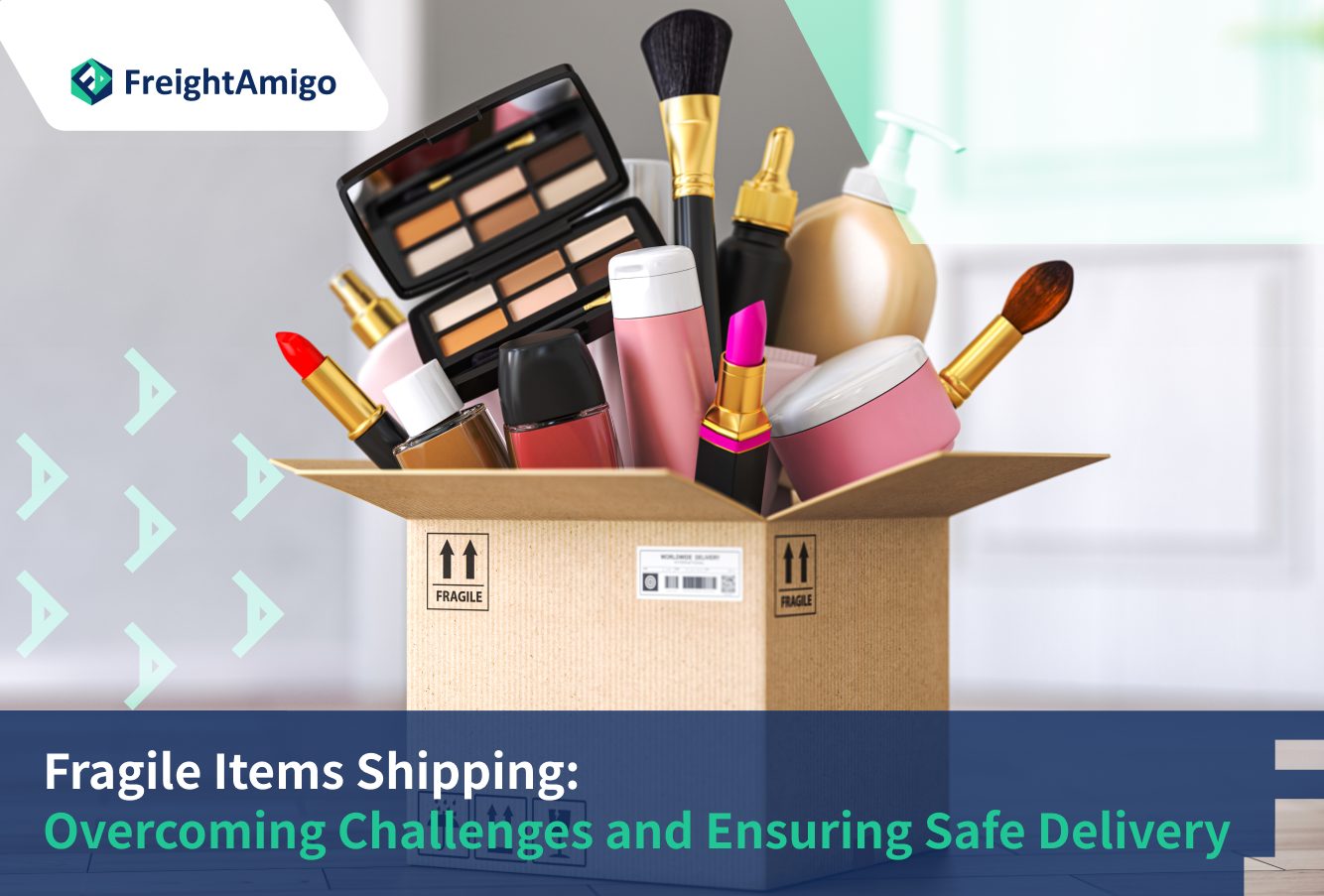In the world of logistics and shipping, handling fragile items requires special care and attention. Fragile items, such as cosmetics and personal care products, face unique challenges during transportation and storage. Ensuring their safe delivery is crucial for both the reputation of the brand and the satisfaction of the end consumer. In this article, we will explore the various challenges faced in shipping fragile items, provide strategies to overcome these challenges, and highlight the importance of proper packaging and handling.
Latest update on 24 January, 2024 by Aurora Park– Marketing Analyst at FreightAmigo
Want to compare the best Express, Air Freight, Sea Freight, Rail Freight & Trucking rates so as to have better control on cost?
Understanding Fragile Items Shipping
Shipping fragile items, including cosmetics and personal care products, requires a deep understanding of the unique characteristics of these goods. Fragile items refer to products that are delicate, prone to breakage, or require specific conditions to maintain their quality. These items can include glass bottles, sensitive electronic devices, or perishable goods.
The transportation and storage of fragile items involve careful handling, appropriate packaging, and adherence to specific regulations and guidelines. Failure to meet these requirements can result in damaged products, financial losses, and even harm to the end consumer. Therefore, it is essential to address the challenges associated with fragile items shipping and implement effective strategies to ensure safe delivery.
Challenges in Fragile Items Shipping
Shipping fragile items presents a range of challenges that need to be overcome to protect the integrity of the products during transportation. Let’s explore some of the key challenges faced in shipping fragile items and discuss strategies to mitigate these challenges effectively.
1. Packaging and Protection
One of the primary challenges in fragile items shipping is selecting and implementing appropriate packaging solutions to protect the products from damage. Fragile items, such as glass bottles or delicate electronic devices, require specialized packaging materials and techniques to withstand the rigors of transportation.
To overcome this challenge, it is crucial to invest in high-quality packaging materials that provide adequate cushioning, shock absorption, and stability. Utilizing materials like bubble wrap, foam inserts, and corrugated cardboard can help minimize the risk of breakage during transit. Additionally, implementing proper labeling and handling instructions on the packaging can further reduce the chances of mishandling and damage.
2. Temperature Control
Certain fragile items, such as cosmetics and personal care products, may have specific temperature requirements to maintain their quality and effectiveness. Fluctuations in temperature during transportation can adversely affect these products, leading to spoilage or degradation.
To address this challenge, it is essential to use temperature-controlled shipping methods and storage facilities. This may involve utilizing specialized refrigerated containers or partnering with logistics providers that offer temperature-controlled services. Monitoring systems and data loggers can also be employed to ensure that the products remain within the required temperature range throughout the shipping process.
3. Handling and Transportation
The handling and transportation of fragile items require careful attention to prevent damage or breakage. Fragile items are susceptible to shocks, vibrations, and rough handling, especially during loading, unloading, and transit.
To mitigate this challenge, it is crucial to train personnel on proper handling techniques for fragile items. This includes using appropriate lifting equipment, ensuring secure packaging, and implementing best practices for stacking and loading items. Additionally, partnering with experienced carriers who specialize in fragile item shipping can provide an added layer of expertise and ensure the safe transportation of delicate products.
4. Compliance with Regulations
Shipping fragile items, especially cosmetics and personal care products, requires compliance with various regulations and guidelines. These regulations may include safety standards, labeling requirements, and restrictions on hazardous materials.
To overcome this challenge, it is essential to stay updated on the relevant regulations and guidelines applicable to the shipping of fragile items. This can involve conducting thorough research, seeking guidance from regulatory bodies or industry associations, and working closely with logistics providers who have expertise in compliance. Adhering to these regulations not only ensures the safe delivery of products but also protects the brand’s reputation and avoids potential legal consequences.
5. Tracking and Visibility
Maintaining visibility and tracking the movement of fragile items throughout the shipping process is crucial for ensuring their safe delivery. Lack of real-time information about the location and condition of the products can lead to delays, loss, or damage.
To address this challenge, implementing a robust tracking system is essential. This can involve utilizing technologies such as GPS tracking, RFID tags, or barcoding to monitor the movement of the items. Real-time visibility allows for proactive decision-making, immediate response to any incidents or deviations, and enables better coordination between all stakeholders involved in the shipping process.
Importance of Proper Packaging and Handling
Proper packaging and handling play a crucial role in the safe shipping of fragile items. Fragile items, such as cosmetics and personal care products, require specialized packaging materials and techniques to protect them from damage during transportation. Inadequate packaging or mishandling can result in breakage, leakage, or contamination, rendering the products unusable or unsafe for consumers.
Investing in high-quality packaging materials, such as bubble wrap, foam inserts, or shock-resistant containers, helps cushion fragile items and absorb shocks during transit. Additionally, implementing proper handling procedures, such as gentle lifting techniques and avoiding rough movements, minimizes the risk of breakage.
Proper packaging and handling not only ensure the safe delivery of fragile items but also contribute to customer satisfaction and brand reputation. Customers expect their products to arrive intact and in pristine condition. By prioritizing proper packaging and handling, companies can enhance customer experience, build trust, and establish a positive brand image.
Conclusion
Shipping fragile items, such as cosmetics and personal care products, requires careful attention to details, proper packaging, and adherence to specific regulations. The challenges associated with fragile items shipping can be mitigated through strategic planning, collaboration with experienced logistics providers, and the implementation of best practices.
By investing in quality packaging materials, implementing proper handling procedures, utilizing temperature-controlled shipping methods, and maintaining visibility through tracking systems, companies can ensure the safe delivery of fragile items. Additionally, regularly reviewing and updating processes, as well as prioritizing customer satisfaction, contribute to the overall success of fragile items shipping.
There are different options for cargo transportation. If you want to choose the most convenient and suitable solution, it is best to have the full support of logistics experts! If you are planning to ship goods overseas, please go to the FreightAmigo page for inquiries.
Read More:
Personal Care Packaging | Guide for Shipping Cosmetics | FreightAmigo
Shipping Cosmetics | Regulations and Guidelines | FreightAmigo
Shipping Makeup | Cheapest Way to Ship Cosmetics | FreightAmigo
Personal Care and Cosmetics | Right Shipping Partners | FreightAmigo
If you have any inquiries on logistics/supply chain, feel free to contact FreightAmigo now:
Chat with us online | Hotline: +852 28121686 | WhatsApp: +852 27467829





































